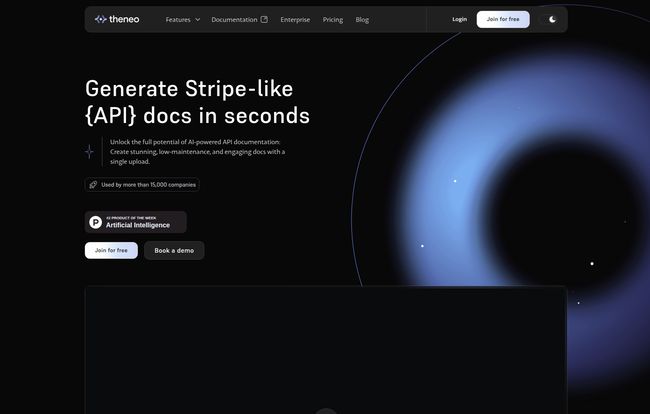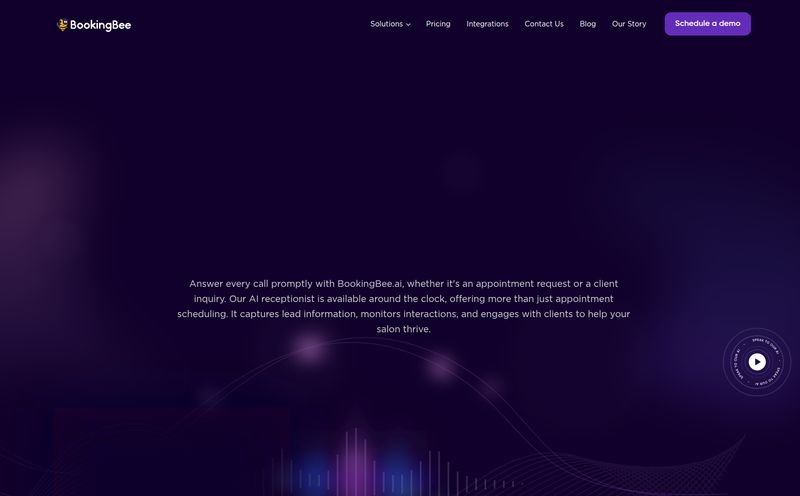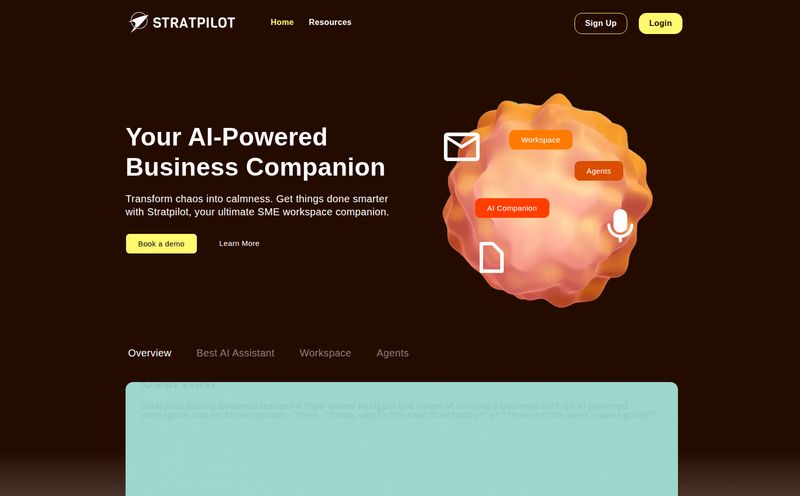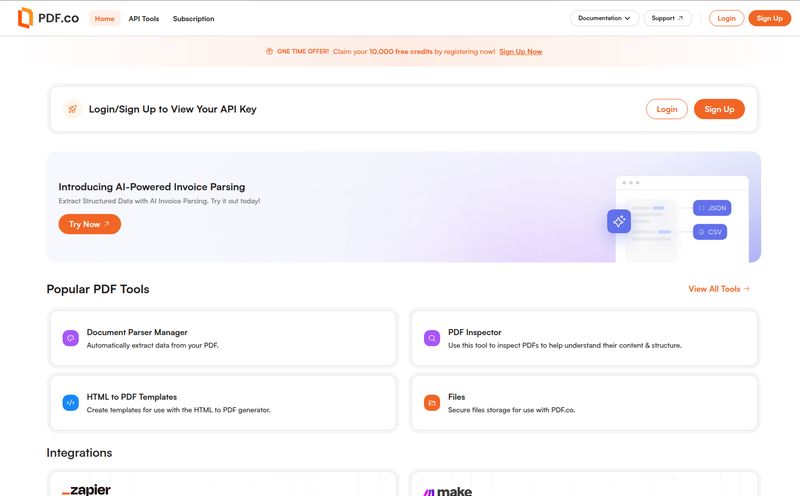API documentation. Those two words can make even the most seasoned developer's soul wither just a little bit. It’s the final, often-rushed chore at the end of a long development cycle. It's tedious, it's thankless, and trying to keep it updated is like trying to nail Jell-O to a wall. We've all seen those docs—the ones that are hopelessly out of date, confusingly written, or just… missing. It’s a real problem.
For years, the gold standard, the holy grail of API docs, has been Stripe. Their documentation is a thing of beauty: clear, interactive, and genuinely helpful. So when a tool comes along and boldly claims on its homepage to help you “Generate Stripe-like (API) docs in seconds,” my ears perk up. As an SEO guy who lives and breathes traffic and user engagement, I know that good docs are more than just a manual; they're a powerful acquisition tool.
That tool is Theneo. And I've been digging into it to see if it can live up to that very big promise.
What is Theneo, Really?
At its core, Theneo is an AI-powered platform designed to pull the painful, manual labor out of creating and publishing API documentation. It’s not just a fancy text editor that makes your code snippets look pretty. It’s a whole ecosystem. It ingests your existing API specifications—from things like Postman Collections or OpenAPI/Swagger files—and uses its AI models to automatically generate comprehensive, human-readable documentation. Think of it less like a ghostwriter and more like a hyper-competent technical assistant who’s had way too much coffee.
Why We Should All Care About Good API Docs
I know, I know, I’m getting on my soapbox here, but this is important. I’ve always felt that great documentation is the most underrated growth hack for any API-first company. It’s your 24/7 salesperson and your best support agent, all rolled into one. Great docs reduce the friction for new developers, which means faster integration and quicker time-to-value for your customers. This directly impacts adoption rates.
It also drastically cuts down on support tickets. If a developer can find their own answer in a well-structured, searchable doc portal, they’re not going to be clogging up your support channels. It's all about Developer Experience (DX), and a good DX leads to happy, loyal developers who will champion your product. That’s why Stripe's docs are so revered; they make a complex product feel accessible.
The Standout Features That Caught My Eye
So, what makes Theneo more than just a pipe dream? A few features really stood out to me as solving real-world, hair-pulling-out problems.
The Magic Wand: AI-Powered Generation
This is the headline act. Theneo’s Docs on Autopilot feature is the main draw. You connect your source, whether it's a GitHub repo with an OpenAPI file or a Postman collection you've been using for testing, and it just… works. Theneo's AI analyzes the endpoints, parameters, and responses, and then generates the descriptions and explanations for you. Is it perfect every time? Of course not, this is AI, not actual magic. But it gets you 80-90% of the way there, turning a multi-day writing slog into a quick review and edit session. That’s a massive win.

Visit Theneo
“Just Ask”: The AI-Powered Search
This might be my favorite feature, because it's built for the end-user. We’ve all been on a doc site, frantically hitting Ctrl+F trying to find that one specific parameter. Theneo’s AI-powered search is different. Users can ask questions in natural language, like “how do I authenticate a user?” or “what are the parameters for the customer creation endpoint?”, and the AI will find and deliver the relevant section. It's like having a helpful guide right there on the page. For increasing user satisfaction and reducing frustration, this is killer.
More Than Just Words: Interactive and Alive
Static documentation is a snooze-fest. Theneo brings your docs to life with an advanced API Explorer. This lets developers make real API calls directly from your documentation pages. They can tweak parameters, send requests, and see the responses in real-time. This turns your docs from a reference manual into an interactive playground, which is an infinitely better way to learn and build confidence in an API.
Keeping Everyone in the Loop with Automated Changelogs
Oh, the changelog. The thing everyone forgets to update until a customer complains about an unannounced breaking change. Theneo automates this too. By integrating with your codebase, it can detect changes to your API and automatically generate changelog entries. It’s a small thing that makes a huge difference in maintaining trust and transparency with your developer community.
Building Your Home: The Developer Portal Experience
Theneo isn't just about generating the content; it’s about giving that content a professional home. You can create fully branded developer portals with custom domains, design templates, and even custom CSS on the higher-tier plans. This is so important. It ensures your documentation feels like an integral part of your product, not some third-party afterthought. It builds brand credibility and makes for a much more cohesive user experience.
Let's Talk Money: A Breakdown of Theneo's Pricing
Alright, the all-important question: what's this going to cost? Theneo's pricing is structured in a fairly standard SaaS model, but the free tier is surprisingly generous. I've put together a quick table to break it down, based on their pricing page.
| Plan | Price | Best For | Key Features |
|---|---|---|---|
| Starter | Free | Individuals, open-source projects, and small teams starting out. | 1 public/2 private projects, 20 team members, basic AI usage limits, auto changelogs, API explorer. |
| Business | $120 /month | Growing businesses that need custom branding and unlimited AI. | Everything in Starter, plus more projects, unlimited AI search & generation, custom domain & branding. |
| Growth | $400 /month | Larger teams needing advanced customization and security. | Everything in Business, plus custom CSS, advanced security, more developer hubs, priority support. |
| Enterprise | Custom | Large organizations with specific compliance and hosting needs. | Everything in Growth, plus self-hosting, SAML SSO, advanced user roles, and custom integrations. |
For my money, the Business plan seems to be the sweet spot for most companies. It unlocks the full power of the AI and, most importantly, the custom branding features that make your developer portal look truly professional.
The Other Side of the Coin: Potential Downsides
No tool is perfect, and it's important to be realistic. While I’m pretty excited about Theneo, there are a few things to consider.
- The Price Tag: While the free plan is great, the jump to $120/month for the Business plan could be a barrier for very early-stage startups or solo founders on a tight budget.
- Trust, but Verify: The AI is fantastic, but it's not infallible. You cant just blindly trust its output without a human review. It might misunderstand a nuanced parameter or generate a description that's technically correct but tonally off-brand. You still need a human in the loop.
- Feature Gating: Some of the really cool, deep customization features like Custom CSS are reserved for the Growth plan and up. This is a pretty standard practice for SaaS, but it's something to be aware of if you have very specific design requirements.
My Final Verdict: Is Theneo Worth It?
So, does Theneo help you create “Stripe-like” docs in seconds? The “in seconds” part is marketing hyperbole, of course. But does it give you the power to create documentation on par with Stripe’s quality in a fraction of the time it would normally take? Absolutely. Yes.
Theneo isn’t just a tool; it's a strategic shift in how we should approach documentation. It turns a painful cost center into a powerful asset for growth, support, and user engagement. If you have a public-facing API and you care about developer experience (which you should), then Theneo is, without a doubt, worth a very serious look. It solves a real, persistent pain point in the software development lifecycle, and it does it with a slick, powerful, and genuinely intelligent platform.
Frequently Asked Questions about Theneo
- What kind of API specifications does Theneo support?
- Theneo is quite flexible, supporting popular formats like OpenAPI (v2 and v3), Swagger, and Postman Collections. This covers the vast majority of modern API development workflows.
- Can I really customize the look and feel of my docs?
- Yes! While the free plan is more limited, the paid plans (starting with Business) allow for custom domains, custom branding, and logo uploads. The Growth plan goes even further with custom CSS for complete design control.
- How accurate is the AI-generated content?
- It's surprisingly good. The AI is trained to understand API structures and generate relevant, clear explanations. However, it's best to treat it as a powerful first draft. You should always have a human review and refine the content to ensure accuracy and match your brand's voice.
- What are the main limitations of the free Starter plan?
- The main limitations are the caps on AI usage. You get a set number of AI-powered search queries and AI-assisted doc generations per month. You also don't get custom domains or branding, so your docs will have Theneo branding.
- Does Theneo integrate with my existing CI/CD pipeline?
- Yes, it's built for modern dev workflows. It offers integrations with tools like GitHub Actions, Bitbucket, and more, allowing you to automate documentation updates as part of your deployment process.
Conclusion
In the end, documentation will probably never be the most glamorous part of building software. But tools like Theneo are transforming it from a dreaded obligation into a genuine opportunity. By automating the grunt work and layering on powerful features like interactive explorers and AI search, it lets teams build documentation that people actually want to use. And that might just be the most exciting development in this space in years.
Reference and Sources
- Theneo Official Website: https://www.theneo.io/
- Theneo Pricing Page: https://www.theneo.io/pricing
- Stripe API Reference: https://stripe.com/docs/api



